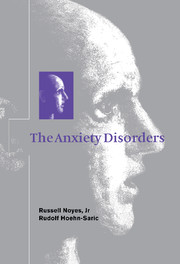Book contents
- Frontmatter
- Contents
- Preface
- 1 Normal anxiety and fear: psychological and biological aspects
- 2 Generalized anxiety disorder
- 3 Panic disorder and agoraphobia
- 4 Social phobia
- 5 Specific phobia
- 6 Posttraumatic stress disorder
- 7 Anxiety in the medically ill: disorders due to medical conditions and substances
- Index
7 - Anxiety in the medically ill: disorders due to medical conditions and substances
Published online by Cambridge University Press: 22 March 2010
- Frontmatter
- Contents
- Preface
- 1 Normal anxiety and fear: psychological and biological aspects
- 2 Generalized anxiety disorder
- 3 Panic disorder and agoraphobia
- 4 Social phobia
- 5 Specific phobia
- 6 Posttraumatic stress disorder
- 7 Anxiety in the medically ill: disorders due to medical conditions and substances
- Index
Summary
Definition
Anxiety disorders are not only prevalent among medically ill persons but are associated with substantial morbidity. These disorders are heterogeneous and have varying relationships with coexisting physical illness. Most are reactions to the stress of developing or continuing illness and represent adjustment disorders. They also arise from biological disturbances that accompany physical illness or its treatment and are classified in DSM-IV as disorders due to medical conditions or substances (American Psychiatric Association, 1994). Others represent preexisting conditons, such as generalized anxiety or panic disorder, that persist following the development of physical illness.
Importance of anxiety in the medically ill
Much of the importance of these disorders derives from their varied interaction with physical illness. To begin with, anxiety and associated autonomic arousal may contribute to the development of disease or complicate the course of existing conditions. For example, anxiety symptoms appear to increase the risk of hypertension, coronary artery disease, and death following myocardial infarction (Hayward et al., 1990). The reverse is also true; physical illness may precipitate, exacerbate, or worsen the course of an anxiety disorder. For example, illness may be associated with the onset of panic disorder or cause the re-emergence of attacks in persons whose symptoms had been controlled (Roy-Byrne et al., 1986). Conditions or treatments that are associated with increased adrenergic activity, such as cardiac or respiratory failure, may increase anxiety symptoms (Katon, 1991). Regardless of the mechanism, coexisting anxiety disorders are associated with lower levels of functioning and well-being in patients with chronic medical conditions (Sherbourne et al., 1996).
- Type
- Chapter
- Information
- The Anxiety Disorders , pp. 285 - 334Publisher: Cambridge University PressPrint publication year: 1998



